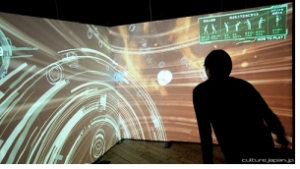2. The technologies we use are increasingly cloud-based, and our notions of IT support are decentralized.
3. The world of work is increasingly collaborative, driving changes in the way student projects are structured.
4. The abundance of resources and relationships made easily accessible via the Internet is increasingly challenging us to revisit our roles as educators.
5. Education paradigms are shifting to include online learning, hybrid learning and collaborative models.
6. There is a new emphasis in the classroom on more challenge-based learning and similar methods foster, which more active learning experiences, both inside and outside the classroom.
NEAR TERM: ONE YEAR OR LESS (IN OTHER WORDS, NOW)
MOBILE APPS. Mobile apps are obviously no longer cutting-edge technology. As of October 2011, 18 billion apps had been downloaded in the Apple marketplace, and more than 10 billion in the Android marketplace (and counting). Students are using apps for everything from note-taking and sharing, to virtual dissection, and creating video and audio. And according to the report, colleges are creating apps to help students navigate school services and resources.
Some institutions are creating programs to teach student entrepreneurs how to create apps from scratch and to market them. One piece to add to the Horizon report: Startup Weekends Edu provide the same service -- organized by peers -- for free. What's more, lectures and slides from Stanford University's iPhone and iPad Apps Course is available online for free through iTunes U.

Flickr:Chirantan Patnaik
TABLET COMPUTING. The iPad is scorching the competition in the tablet field -- the report states that 97% of all tablet-based and 46.8% of all mobile Web traffic comes from the Apple's tablet. Motorola, Samsung, and Amazon all offer their own versions, but despite their lower prices, the iPad has dominated the market at large, and specifically at higher-ed institutions. Tablets are useful tools for learning because they're portable and light, can replace heavy textbooks, and can be used for fieldwork, and more universities are offering tablets to students as part of their tuition costs.
At the University of California, Irvine, students use the iPad to explore images of body structures and radiographic films. At Drew University's Wall Street Semester program, students create spreadsheets and presentations and interpret financial information on their iPads. At the University of Adelaide, all first-year science students' textbooks will be replaced by iPads.
MID-TERM: WITHIN TWO TO THREE YEARS
GAME-BASED LEARNING. Gaming in education is not exactly cutting-edge territory for MindShift readers, but from the perspective of traditional institutions, it's still a few years from becoming a regular practice in classrooms. The appeal of games with learning comes from the ability to capture student interest, motivate them to progress to higher, more difficult levels of learning, and learn from and interact with other students.
Other examples from the report: Purdue University's Serious Games Center focuses on researching new means of collaboration with Serious Games in virtual environments; massively multiplayer online (MMO) games like Minecraft and World of Warcraft are being used in course curriculum, and leverage the best of game theory in education: "teamwork, leadership, and discovery."
One more piece to add to the Horizon report: University scientists are using crowd-source games to carry out research; in September, scientists from the University of Washington, who created the online game FoldIt, announced that players had "deciphered the folding of a protein important in AIDS research," according to a Boston Globe article.
Alternate-relate games are also used to learn, such as Jane McGonigal's Evoke, a social networking game that compels students to create solutions for real-world problems. Stanford's "Septris" is an HTML5 mobile simulation game used by doctors and nurses about how to identify, triage, and manage sepsis. The online game Ikariam allows students to create ancient civilizations, including infrastructure and economies.
The challenge, the writers say, is figuring out how to use "traditional educational content" in a game setting. But knowing that, for example, the average MMO gamer spends 10-15 hours per week researching information that will help them move along in the game, keeps educators interested in game-based learning practices.
LEARNING ANALYTICS. The rise of Big Data in education is perhaps one of the biggest game-changers and has drawn the attention and financial support of the big guns. The goal of using analytics is to help educators pinpoint students' struggles and needs and customize what they teach based on hard data. That said, most captured data can't identify intangible, unquantifiable qualities like creativity, leadership, and innovation, which are as equally important to student achievement.
Some examples: The Signals Project at Purdue University generates reports on students, identifying risk level and solutions for struggling students. CoreDogs allows students to get feedback and assessments from educators while they complete exercises. The University of Minnesota uses data from its course management systems to help lower achieving students estimate their final grades more accurately so they can better prepare for term exams and projects. Harvard's Mazur Group developed Learning Catalytics, which gives real-time feedback during class to support its peer-to-peer instruction. "Faculty can engage students with questions about course material with numerical, algebraic, textual, or graphical responses, and the platform helps group students for follow-up discussions," report states. (Read more about professor Eric Mazur's practice.)
FORESEEABLE FUTURE: FOUR TO FIVE YEARS
GESTURE-BASED COMPUTING. If you're not sure what this means, refer to the Microsoft Kinect system, which eliminates the hand-held controllers of video games and uses the player's gestures to control the game. But what is its role in learning? For those with special and needs, gesture-control devices offer the prospect of independence, to some degree.

Daniel Choo
In schools, a few examples: Morp Holuminescnece at Ball State University uses body gestures to change the amount of light in a room. At the Norrkoping Visualization Centre and the Center for Medical Image Science and Visualization in Sweden, users can conduct a virtual autopsy using a multi-touch table, making virtual cross-sections and examining layers of skin, muscle, and bone.
Some exciting prospects: MIT graduate students are working on 3Gear System, which will allow human interaction with computers and digital devices more natural; Extreme Reality is working on creating software that allows computer control with hand gestures.
THE INTERNET OF THINGS. Those who have seen the Cisco video ad called Day of Made of Glass have a sense of what this term means: Everything is connected. Smart objects connect us to information and information back to us.
How's this playing out in higher ed? Because it's still evolving and fairly new, examples are sparse, and used mostly for tracking people, objects, and spaces. At Northern Arizona University, student ID cards track their class attendance, and El Paso Health Sciences Center at Texas Tech University tracks science lab equipment and resources.
But here's an intriguing application from the report:
"Anthropology and history departments will have an instant window into the condition of the objects, with the Internet being the mechanism for real-time monitoring of current location, environment, and movement of an object in their care or collections. Once such information is accessible, it is easy to imagine it being attached to other sorts of information in ways that will blur the line between the object itself and content related to it. For example, every bone in an Allosaurus skeleton has a story — when it was discovered, its position in the body, the temperature at which it is being stored, its provenance info, and more. An Internet of Things would make it simple to attach all that information directly to the bones themselves via an IP-enabled smart object that adds a constant stream of monitoring information about the physical object."
There's lots of insightful information here. We would love to hear back from readers about how these trends might be playing out in your world.
[UPDATE: The most recent version of this article includes links that were originally in the post but inadvertently deleted.]




